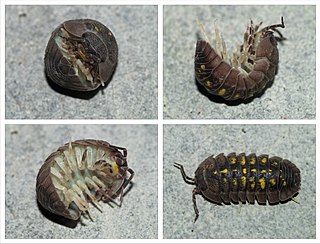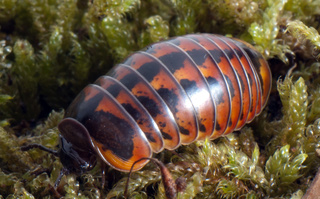
Armadillidium is a genus of the small terrestrial crustacean known as the woodlouse. Armadillidium are also commonly known as pill woodlice, leg pebbles, pill bugs, roly-poly, or potato bugs, and are often confused with pill millipedes such as Glomeris marginata. They are characterised by their ability to roll into a ball ("volvation") when disturbed.

Armadillidiidae is a family of woodlice, a terrestrial crustacean group in the order Isopoda. Unlike members of some other woodlice families, members of this family can roll into a ball, an ability they share with the outwardly similar but unrelated pill millipedes and other animals. This ability gives woodlice in this family their common names of pill bugs or roly polies. Other common names include slaters,potato bugs, butchy boys and doodle bugs. Most species are native to the Mediterranean Basin, while a few species have wider European distributions. The best-known species, Armadillidium vulgare, was introduced to New England in the early 19th century and has become widespread throughout North America.

Pill millipedes are any members of two living orders of millipedes, often grouped together into a single superorder, Oniscomorpha. The name Oniscomorpha refers to the millipedes' resemblance to certain woodlice (Oniscidea), also called pillbugs or "roly-polies". However, millipedes and woodlice are not closely related ; rather, this is a case of convergent evolution.

Glomeris marginata is a common European species of pill millipede. It is a short millipede, rounded in cross-section, which is capable of rolling itself up into a ball ("volvation") when disturbed. This behaviour is also found in the pill woodlouse Armadillidium, with which G. marginata is often confused.

Glomerida is an order of pill-millipedes found primarily in the Northern Hemisphere. Also known as northern pill millipedes, they superficially resemble pill-bugs or woodlice, and can enroll into a protective ball. They have twelve body segments, 17 to 19 pairs of legs, and males have enlarged rear legs involved in mating. The order includes about 30 genera and at least 280 species, including Glomeris marginata, the common European pill-millipede. The order contains members in Europe, South-east Asia and the Americas from California to Guatemala. Although historically considered closely related with the similar sphaerotheriidans that also enroll, some DNA evidence suggest they may be more closely related to glomeridesmidans, a poorly known order that does not enroll.

Glomeris is a genus of pill millipedes that belongs to the family Glomeridae and order Glomerida. The genus Glomeris is the largest within the family Glomeridae, comprising about 100 species along with a few hundred subspecies, varieties, forms, or genetic aberrations. The genus is primarily distributed in Europe, but can also be found in the Canary Islands, North Africa, and North-western Anatolia.
G. marginata may refer to:

Sphaerotheriida is an order of millipedes in the infraclass Pentazonia, sometimes known as giant pill millipedes. They inhabit Southern Africa, Madagascar, South and Southeast Asia, Australia and New Zealand. Like the Northern Hemisphere pill millipedes of the order Glomerida, these millipedes can roll into a ball when disturbed. When they are rolled-up, most sphaerotheriidans reach a maximum size of a cherry or golf ball, but some species from Madagascar can even reach the size of an orange. When rolled-up, predators are unable to unravel giant pill millipedes since the margins of their second and last dorsal plates fit perfectly into one another, creating a sealed ball. A few giant pill millipede species are able to produce sound, the only millipedes known to do this. This order of millipedes is also unique in that some African species are used for medicinal purposes.

Zephroniidae is a family of giant pill millipedes in the taxonomic order Sphaerotheriida. They occur in southeast Asia from the Himalayas and China south and east to Sulawesi and to Australia, and also inhabit some Philippine islands.

Glomeris klugii is a species of pill millipede within the genus Glomeris and family Glomeridae. The species is highly variable in colouration, with more than 40 varieties and subspecies identified, each displaying unique colour patterns. The diverse colour patterns of G. klugii can be visually striking, and certain patterns are geographically restricted, leading to the species being associated with numerous taxonomic synonyms.

Glomeris connexa is a species of pill millipede within the genus Glomeris and family Glomeridae.

Trachysphaera is a genus of dwarf pill millipedes in the order Glomerida. Just over 30 species are known, making it the third most species-rich genus of Glomerida. Trachysphaera species are patchily distributed throughout Europe and western Asia, extending from Spain to Caucasia. Members of this genus are tiny, with modified appearances resembling that of calcareous stones.

Zoosphaerium neptunus, also known as the giant emerald pill millipede, is a species of millipede within the family Arthrosphaeridae. It is an example of island gigantism, being the largest known pill-millipede in the world, with some individuals reaching a maximum length of 90 mm long. The species is endemic to Madagascar, where it is known to swarm at certain times of the year. Z. neptunus is the only known species within the order Sphaerotheriida that is known to exhibit this mass swarming behaviour.

Glomeris sublimbata, also known as the marbled pill millipede, is a species of pill millipede belonging to the genus Glomeris and the family Glomeridae.

Glomeris aurita, also known as the golden-eared pill millipede, is a species of pill millipede belonging to the genus Glomeris and the family Glomeridae.

Glomeris oblongoguttata, also known as the painted lady pill millipede, is a species of pill millipede belonging to the genus Glomeris and the family Glomeridae.
Armadillidium maculatum, also known as the Zebra Isopod or Zebra Pillbug is a Armadillidium species of woodlouse, named for it’s black and white patterns. It is native to southern France.

Glomeris pustulata is a species of pill millipede belonging to the genus Glomeris and the family Glomeridae.

Glomeris hexasticha, also known as the Eastern six-striped pill millipede or the diagonal-striped pill millipede, is a species of pill millipede within the family Glomeridae and order Glomerida. The pill millipede is widely distributed within many European countries, with the species consisting of over twenty different subspecies.














